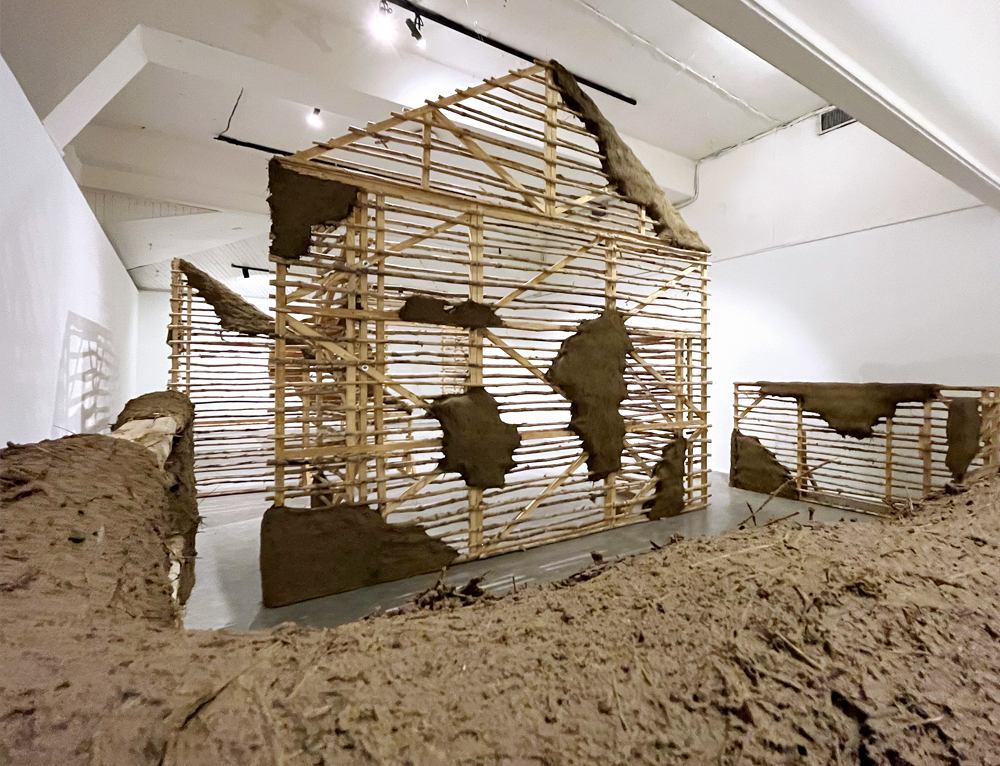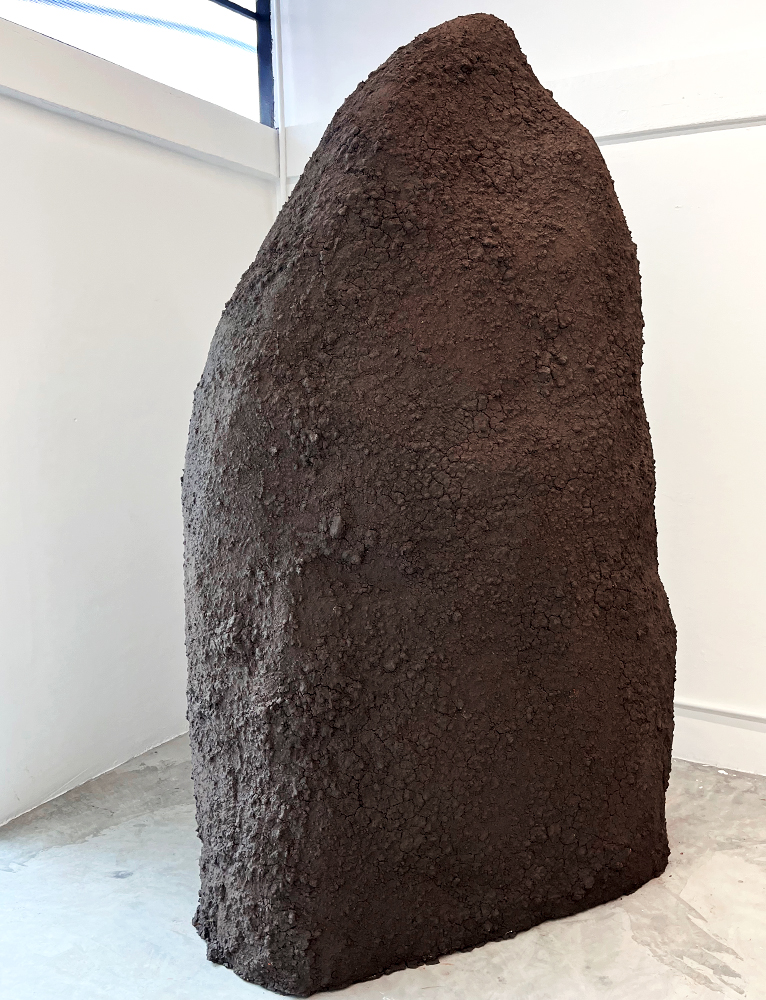Puerta del Sol
Solo Show at Panama Museum of Contemporary Art
February 1 – May 11 2024
Curated : Juan Canela
Panama is the only place where it is possible to observe the sun
at sunrise over the Pacific Ocean and at sunset over the Atlantic
Ocean. Undoubtedly the sun, the sea and its geographical
position mark the nature, history and idiosyncrasy of this piece
of land that unites north and south, and connects east and
west. That tropical sun, which dries the land after the rain, also
shapes the way of life of the people of the isthmus.
The artistic practice of Cisco Merel (Panama, 1981) emerges
unequivocally from the cultural complexity of his homeland, his
Chinese-Afro-Panamanian roots, and the road he has traveled.
He begins his artistic practice in the street, in the world of street
art and graffiti, which gives him a significant understanding
of public space and its elements. During this initial period, he
also became interested in different manifestations of popular
art, such as carnival cars and different types of carpentry, which
gave him a substantial knowledge of traditional Panamanian
crafts. After beginning his artistic education at Ganexa
University, and having completed it in Europe, he returns to
Panama where he collaborates for more than ten years in the
workshop of Carlos Cruz-Diez, which allows him to acquire
advanced knowledge in terms of technological research applied
to art, deeply marking his artistic language. All these influences,
as well as an extraordinary curiosity for the world around him,
make up a constantly evolving practice, in which a masterful
use of abstract language and color open spaces for the
significance of the materials used. His interest in architecture,
social contrasts and popular culture are reflected in different
series of works that, over the years, have an impact on some
of the most characteristic elements of Panama City: the
Diablos Rojos, Afro-Antillean architecture, traditional signage,
skyscrapers, or their contrasts are the protagonists. But at a
certain point Cisco felt the need to look beyond the city, to look
back and investigate its origins. It is there when, little by little,
along with the use of mechanical techniques and industrial
materials that had characterized his production up to that
moment, appears an interest in the use of organic materials
and artisanal ways of making, typical of the communities of the
countryside.
Gate of The Sun is an exhibition that brings together a series of
works by Cisco Merel made in recent years, and others made
specifically for the occasion, in which earth as a material plays
a leading role. Having spent much of his childhood and youth
in the village of his grandmother Mercedes in Los Santos, a
house made with stone, earth and quincha in the traditional
way, Cisco decides to return to the area, and spend some time
living and experimenting with the material and traditional
techniques. It is from then on, around 2018, when he begins
to use the earth in a conscious way. The land as a building
material, as a home; as an identity element, carrying symbolic
and ideological contents; as a container of the pre-Columbian
universe, but also in a conflicting way, the popular: indigenous,
mestizo and criollo.
Hiperlíticos (2022) is already interested in a mystical imaginary,
bringing together a series of paintings of abstract forms
reminiscent of ancient telluric monoliths, but which could
also be sculptures of an ancestral future. These forms become
matter in Puerta del sol (2023), a large earthen sculpture
that rises and receives us imposingly as a totem. The
series Convergencias (2022) presents a series of geometric
assemblages, halfway between painting and sculpture, in
which clay, stainless steel and color allude to the vital contrast
having grown up between the city and the countryside;
between the imposed construction materials of the great
skyscrapers so poorly adapted to the tropical weather, and the
use of earth, whose traditional, fresh and durable techniques
are gradually being lost. The immersive installation Gone
With The Wind (2024) hangs a series of colored ribbons that
invite and wrap us as we walk along a hallway that leads to a
distorted reflection, alluding to the Afro-Caribbean culture of
the coast of Colon and its social and cultural complexity.
La Casa (2024) is a site-specific installation that replicates,
playing with memory and memories, a traditional earthen
house construction. Leaving the foundations on view, and
allowing the public to walk through and inhabit it, the structure
connects us with the intimate sense of home, with the
archetypal notion of the house, or with the symbolic protection
of the material. The house is understood here as a refuge, but
also as an element to which we are irremediably linked as
individuals. The house marks and shapes us, it is protection
and construction, but it can also be defenselessness and
destruction. Land is also a matter of belonging, of gathering,
of community identification, and this work reconnects us with
the idea of the junta de embarre, a characteristic event of the
countryside in which a neighbor’s house is built with earth in
one day with the help of the whole community, being both
construction and celebration. Comején (2024) is a sculpture
that mimics the construction of a termite nest, metaphorically
entering the layers of the social structure, and revealing its
reflection in a mirror. Although this reflection may appear to be
an illusion, he uses resources in a subtle and exhausting way,
underlining the voracity with which the present is consumed,
with no regard for tomorrow. Several series unfold through the
space; Origen (2018) are the first paintings made with earth
by Cisco, in which he begins to play with the material and
geometric shapes; in Terrenos (2022) the geometric is combined
with the earthy backgrounds, forming plots of color and
earth; and in Primitivo/Junta barro (2023-2024) the geometric
disappears to give way to organic forms where the earth and
its organicity is already the undisputed protagonist, welcoming
small details in color. The latter are almost like pieces of territory,
lake bottoms or riverbeds dried in the sun.
Cisco’s relationship with the earth is particular. He does
not work it in the traditional way, molding and baking, but
combines his knowledge of materials and contemporary
construction techniques with the old ways of making,
generating new possibilities. His works create a dialogue
between automotive paint, plastic or steel with a mixture of
earth, water and sun-dried binders, which give them their
characteristic appearance. In the same way, it is significant
how he combines abstract language with colors and shapes
that increasingly submerge him more and more in the organic
and the natural. At some point, this dialogue of languages,
materials and techniques shows the coexistence, sometimes
in opposition, of modernity with the ancestral, of technical and
scientific progress with the survival of traditional forms and
knowledge.
Overflowing that supposed opposition, the works gathered
in this exhibition propose new ways of exploring notions such
as identity, the spiritual, memory, the relationship with the
territory, the community or the home, not from a nostalgic
position, a historiographic or anthropological look, but from a
practice of contemporary materiality that looks to the future
while respecting the ancestral.
“All poetry that, in its deepest structure, stimulates the measure
according to organic demands, and not through formal
affectations, produces freedom”1
said Édouard Glissant. Perhaps
these poetic forms dried by the sun of the isthmus, and their
measures nourished by those old structures that should never
be forgotten, help us to imagine new possibilities of future


